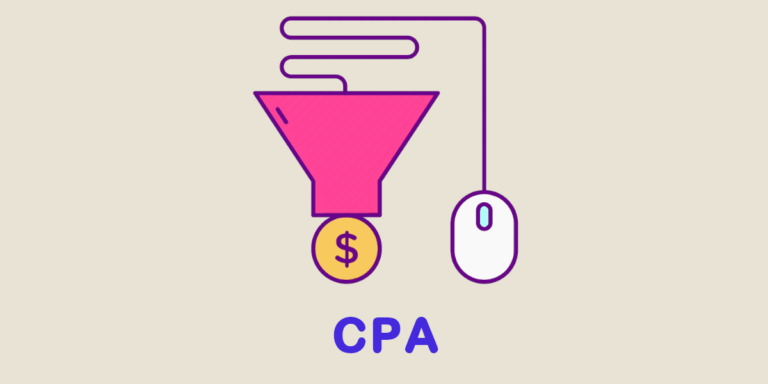While cost-per-click and cost-per-thousand impressions are very often used by digital marketing professionals, it is also possible to invoice on a CPA basis. What exactly is this? How is it calculated? What are the advantages and disadvantages? How can you optimise the cost per action? All the answers are in this article.
Definition of the CPA
CPA (also known as cost per acquisition) refers to the cost of advertising in relation to a specific action. For example, filling in a contact form, making a sale, subscribing to a newsletter, requesting a quote, etc.
With this digital pricing model, advertisers only pay when web users carry out the tasks specifically defined upstream.
Under this model, it is the publisher who takes most of the risk, rather than the advertiser. From now on, their commission will depend exclusively on the conversion rate of their ads. If their performance is zero, they will not incur any expenses.
This method of remuneration is very often found in affiliate marketing (or influencer marketing). In other words, a company will only pay a content creator if they manage to sell a branded product via their affiliate link.
How is the CPA calculated?
There are several methods for calculating the cost per acquisition. The simplest is as follows:
CPA = Marketing budget spent / total number of (your objective)
Your objective may relate to the validation of contact forms, newsletter subscriptions, event registrations, the purchase of a particular product, total sales, etc.
For example, you want to calculate the total cost of your sales. You’ve spent €10,000 and collected 200 sales. Here’s the formula:
CPA: 10,000 / 200 = 50. Each sale costs you €50.
Please note: When calculating the cost per acquisition, you need to keep an eye on :
- The marketing budget: this is the expenditure incurred specifically for an action. For example, if you want to know the CPA of newsletter subscriptions, you should only take into account the marketing expenses incurred to achieve this objective (such as the creation of the landing page, the pop-up, the time spent by employees, the tools used, etc.).
- The period: to gain as much perspective as possible, we advise you to carry out the calculation over a period of at least 3 to 6 months.

What is the advantage of cost per acquisition?
Controlling advertising costs
Using CPAs makes it easier to put costs into perspective in relation to specific marketing objectives. This is because advertisers only pay when the defined action has actually been carried out. So they can measure their return on investment.
Because of this control over expenditure, a large proportion of marketers consider that cost per action is the best way to buy advertising.
Reduce your initial investment
The very principle of CPA is to pay once the objective has been reached. In other words, the sale precedes the payment. This means that you don’t need to commit a substantial budget to this pricing method.
That said, you don’t necessarily know in advance how much you’re going to spend on your marketing campaigns. If you want to achieve a significant volume of objectives within a defined budget, CPCs (cost per click) or CPMs (cost per thousand impressions) may be more appropriate.
Measuring the relevance of marketing actions
CPA enables you to identify the most effective actions in relation to your marketing objectives. For example, if you use different communication channels (social networks, YouTube, emailing, website, etc.), the cost per action shows you the return on investment for each of them. This will enable you to focus your efforts on the channel that costs you the least, with maximum results.
How can I make the most of my CPA?
The ultimate aim of companies is to reduce the cost per acquisition. In other words, to buy more shares for the same price, or to buy the same number of shares for a lower price.
Improving targeting
By offering ads to prospects interested in your offer, you can reduce the cost of your marketing efforts while optimising the conversion rate.
But to achieve such a result, it is vital to improve your customer knowledge. This obviously requires the use of a wide range of data (data from CRM, social networks, data providers, etc.).
The better you know your target audience, the more effective and relevant you’ll be able to communicate with them.
Configure several objectives
While the aim of all marketing campaigns is to increase the number of sales, they can involve a multitude of actions. For example, sending newsletters to prospective customers, inviting prospective customers to an exclusive event, getting existing customers to complete a survey, etc.
By determining the cost of each action carried out, you can identify the most effective actions. But to do this, you need to calculate the CPA of all these actions. In other words, you need to configure the CPA into a multitude of micro-objectives. Gradually, this will enable you to adjust your marketing strategy.

Things to remember
- CPA stands for cost per acquisition It allows advertisers to pay only when an objective is reached.
- As well as giving advertisers greater control over their advertising spend, this invoicing method allows them to reduce their initial investment and measure the performance of each action.
- To optimise this cost per acquisition, it is important to know your target audience well, and to set different objectives for all the marketing actions you implement.










